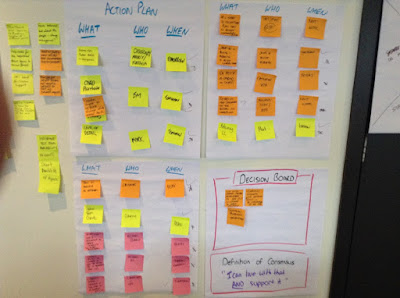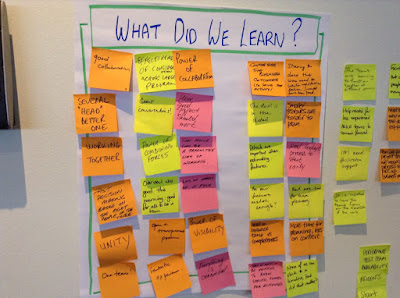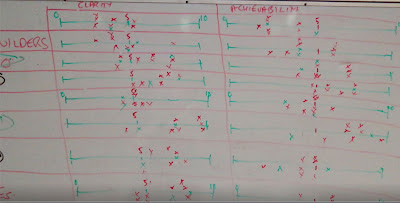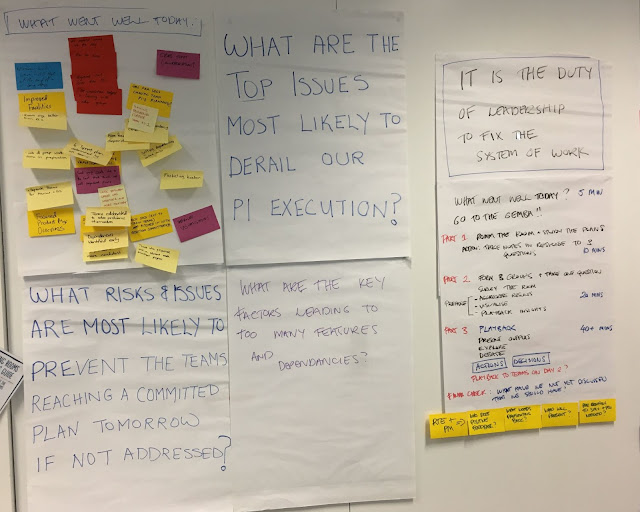Let’s start with a simplified version of the PI Planning agenda:
Day 1:
- Present the vision (Leadership)
- Create a draft plan revealing the flaws and challenges in achieving the vision (Teams)
- Face into the insights generated by the teams (Leadership)
Day 2:
- Communicate the response to the team insights (Leadership)
- Breathe a sigh of relief and craft an achievable set of objectives with a supporting plan (Teams)
As a coach or facilitator, you have a golden opportunity – you need to make the most of it. The first hint is that if you’re the RTE, try and get an external facilitator (be it a coach or somebody else). You want a voice in the discussions.
Expectation Setting
The “official agenda” shows management problem solving occurring from 5-6pm. The reality is most sessions will run 2-3 hours – I’ve run as late as 11pm, and I’ve heard stories from Dean of post-midnight finishes. Participants need to know you’ll be asking them to work late and understand why. It gives them the chance to fly in the night before rather than trying to stay awake after an early morning flight, and to warn their families.When you’re scheduling, provide a break (it’s been a busy day) and preferably some food (brains need food to face into tough discussions). I typically suggest scheduling the session for 6-9pm to set appropriate expectations, then work towards finishing between 8 and 8:30. Also, work with your scrum-masters. Help them understand that their primary goal at the end of day 1 is to provide clarity on the problems that need solving. Be ready to remind them of this at the final scrum of scrums.
Structuring the facilitation
I don’t tend to start with a fixed approach to facilitating the session. I’m observing during the day, looking at the types of problems emerging and thinking about the best way to structure the session to help achieve the optimal outcomes. While the leaders are having a break, I take the opportunity to create a working space and setup my visualisations. If at all possible, do it in the PI planning room so you’re surrounded by the day’s work.The Retrospective Option
For this option, I structure virtually the entire conversation around a 4 L’s activity. 4 feedback areas are established (Loved, Learned, Loathed and Longed For), and participants are invited to respond with post-it’s which are then affinity grouped.
Open with “Loved” – it’s good to get some positive acknowledgements flowing but also opens the conversation flow and tends to provide a little more safety for when the discussion gets tough. Then, open each affinity group in turn by asking for participants to elaborate. Virtually every affinity group will hold the seeds of 1-3 actions and/or decisions. Allow the conversation to flow, probing with open questions if necessary but be listening for the seed of an action.
The Simple Study Option
Open with a reflection on what went well. This should be short, but helps prepare to enter quality discussions about challenges.Next, send your group out to study the work. Ask them to tour the room (as individuals) and study each team’s plan visualisation. At its simplest, you might arm them with a pad of post-it’s and a sharpie and ask them to note down the problems they believe need to be discussed for each team. You may also ask something more specific. On one occasion, I created a grid with a row for each team and a request that participants rate (on a scale of 0 to 10) both the achievability and the clarity of each team’s plan. A timebox of 15 minutes generally suffices for this.
Upon their return, collate the results. This might involve the creation of an affinity grouped set of post-its around discussion topics or problems to solve, or some other form of visualisation. The photo below shows the whiteboard where I collated the results of the “achievability and clarity” rating mission.
When collating, you might also choose to help them set some priorities. One technique is to provide 3 separate areas – “Must discuss tonight”, “Should discuss tonight”, “Nice to discuss tonight”. Whatever you don’t make it to becomes a takeaway list for the RTE to facilitate follow-up discussions around in Release Management Meetings.
Now you need to timebox the discussions. I believe Lean Coffee provides a very handy control mechanism. The topic timebox will vary depending on your approach – “team by team” will need longer timeboxes than “problem by problem”. Your goal with each timebox is to arrive at one or more actions or decisions in response to the prompt.
The "Hello Game" Study Option
This is a slightly more structured study option based on Thiagi’s “Hello Game” frame game. The approach involves dividing participants into 3-4 “study groups”. As with the Simple Study Option, participants are given time to roam the room and study the plans. However, they are given a more structured mission. As the facilitator, you need to come up with one “framing question” per group. As members roam the room, they are asked to take notes in response to all 4 framing questions. However, you then enter a second phase. Each study group is assigned one of the framing questions to focus on, and receives an additional 15-20 minutes to survey the room and determine an approach to aggregating, visualising and playing back the key insights in response to their framing question.This is currently my favourite approach, as I find it yields deep engagement and more challenging discussions. There’s a little mayhem as people survey each other, but the one-on-one discussions held to gather their data and the effort the study groups put into visualising it (eg graphs, diagrams) is brilliant. The job of the facilitator, of course, is to spend all day pondering the 4 framing questions that will yield the best insights. As a coach, there are usually some key themes I can see but I’d like to give my participants the opportunity to generate their own learnings rather than hand them out myself. Good question selection facilitates this. I almost always create one or two questions based on the day’s events, but I also have some stock questions up my sleeve such as:
- How have we improved since our last PI planning event?
- How could we have improved our preparation activities to enable a more effective PI Planning?
- What systemic issues are evident in the teams planning that we do not have improvement plans in train to address?
- What are the top issues most likely to derail our PI execution?
- What issues are most likely to prevent the teams reaching a committed plan tomorrow if not addressed?
- In which areas are we facing scope trade-offs, and what is the extent and contributing factors of those causes?
Following is an example of a framing question I used recently to draw attention to something the leadership group really needed to ponder:
- What are the key factors contributing to the overabunce of tech stories and widget based objective statements?
Closing
Once you’ve exhausted the topics opened up by your information gathering approach, there’s a final question to ask:“What have we not yet discussed that we should have?”It’s amazing how often the toughest topic or two of the night open up at this point. Facilitated well, the group should have reached the safety needed to delve into something that felt too controversial in the beginning.
Preparing for Playback
At this point, you can release all the attendees except the RTE and the Product Manager. Your final bit of work is to agree their playback approach for the morning. It’s fairly straightforward.- Agree who will present the “positive feedback”
- For each identified action and decision, identify whether it needs to be fed back to the team in the morning and who (RTE or Product Manager) will speak to it.
- Agree on any pre-briefing that will be given to the Scrum Masters and Product Owners prior to the general Playback session.




